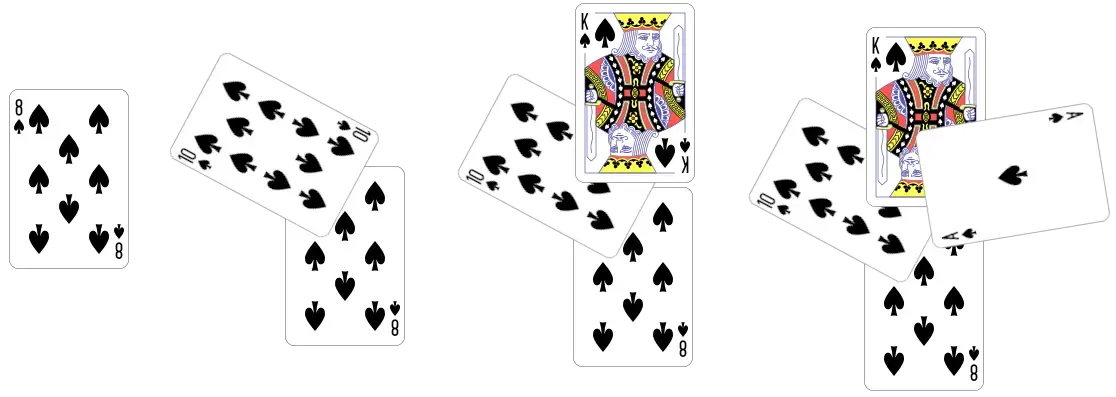Mindi kot - the card game
Introduction
Mindi (or Mindi kot) is a card game played between 4 or more people. The number of people has to be even, because they will be playing in subgroups of two. It is a game of part guesswork part mental calculation as you have to keep in mind what cards were played and which cards the other players might be holding. I am writing this guide so that others may also learn of this game and have the same fun that we had back in the day.
Terminology
- Bheru (Buddy or Partner) : Two people who are in a subgroup. They sit opposite each other in a circle of players. If they win, they win as a team.
- Mindi (Ten) : The cards of number 10. They are the most import cards in the game. All teams try to gather as many of mindis as they can. If a team wins an hand, and it contains one or more cards of 10, that team is said to have gathered that number of mindis.
- Haath (Hand) : If a team wins a hand, but there are no mindis in that hand, it is simply called haath or Hand. In case all the teams have the same number of mindis at the end, their number of haath are counted to decide the winner.
- Baavaniyo (52) : At the end of the game, if a team is not able to secure any mindis, that team is said to have received a Baavaniyo.
- Kotiyo (10 million) : Similar to Baavaniyo, but worse. If a team is not able to secure any haath or mindi, they receive Kotiyo. Very humiliating.
- Sar (Pronounced like sir, Trump card): This is the suit of card that is decided either by random means or by the players. (more on that later.)
History
Mindi kot is played in India, especially in the Western states of Maharashtra and Gujarat. I have read that “mindi” is derived from the Gujarati word મીંડું (pronounced mee-n-doo), which means zero but refers to the 10, which is the only playing card that includes a zero. The word ”kot” is used in several South Asian card games for a victory in which the opponents score nothing. However, as with many Indian names transcribed to English, other spellings are also used, for example Mendhi Coat where mendhi is interpreted as the Marathi word for ‘sheep’, or even Mendhi Goat.
The game
The deck is a combination of two or more decks with lower cards removed. Usually the number of decks is same as the number of teams playing. 4 players = 2 teams -> 2 decks. 6 players = 3 teams -> 3 decks. Lower cards (2-7) are removed from the decks so that rounds are less tiresome.
NOTE: One thing to keep in mind is that each player should get an odd number of cards. If this does not happen, then no one will be able to win!
The game is played in rounds. In each round, the players play their cards in turns, in a circular fashion. Once the players’ cards run out, the game ends and a winner is declared. The turns in the round go as follows:
- A player deals the cards. If this is the first round then all the players draw cards from a shuffled deck and whoever has the highest card has to deal, otherwise, someone from the losing team has to deal.
- The player to the left of the dealer chooses a card (lets call it card number 1) and puts it in the center.
- The second player puts their card (card number 2) on the previous card.
- If Card 2 is higher than Card 1, then the haath of second player’s team is stronger.
- This goes on until the last player in the turn. Depending on his card, the haath (or mindi ) goes to the team with the strongest haath. Basically the team which has put the heaviest card will win. Now there is a condition - all the cards that are played in one loop have to be of the same suit. This is entirely feasible in the first few loops, but when cards are few, it could be possible that the players are out of spades or hearts. What happens then?
That’s when sar comes in. sar is the suit that is supreme. A card of the same suit as sar will trump any other card in the round, except other sars. sars are decided by two methods:
- Before shuffling, a random card is put face down on the side, only to be revealed when a sar is needed.
- Nothing is hidden, but the first player who needs a sar will select a suit from his cards at the very moment.
At the end of a round, all the teams count their totals. First if a team has the highest number of mindis (hands with a 10 in them), they win. If all teams have equal mindis then the total number of haaths are considered.
Rules
- Cards value goes in this order: Ace > King > Queen > Jack > 10 > 9 > 8 > 7 > 6 > 5 > 4 > 3 > 2
- The above holds true, unless one of the card is sar. Then that card becomes the strongest.
- If two cards of sar are played, then they follow rule #1.
- The team which lost the previous game has to deal the cards in this round.
Disclaimer
Do not come to me saying that my method is wrong with words like “My village does it differently!”. Of course they do it differently, this is India! Methods change every five villages. Other than that, if you feel like you could help in adding to this guide, email me or create a PR. I will be happy to add to it. Below are some common plays seen when playing mindi. You can skip them if you want, up to you. I will keep updating these as and when I get time or remember something. If you have any questions, feel free to email me.
Plays
- Scenario: Four players, first play.
The first player plays an 8 of spades, it being the lowest card they have. The second player from the other team puts a 10 directly! This is done in hopes that since this is the first play, all players have plenty of cards and their teammate player #4 is the last to play. There is a very high chance that they will be able to overcome whatever player #3 puts in and it will be an easy mindi capture. Same play can be done with any number of players, as long as the last player is in your team.

